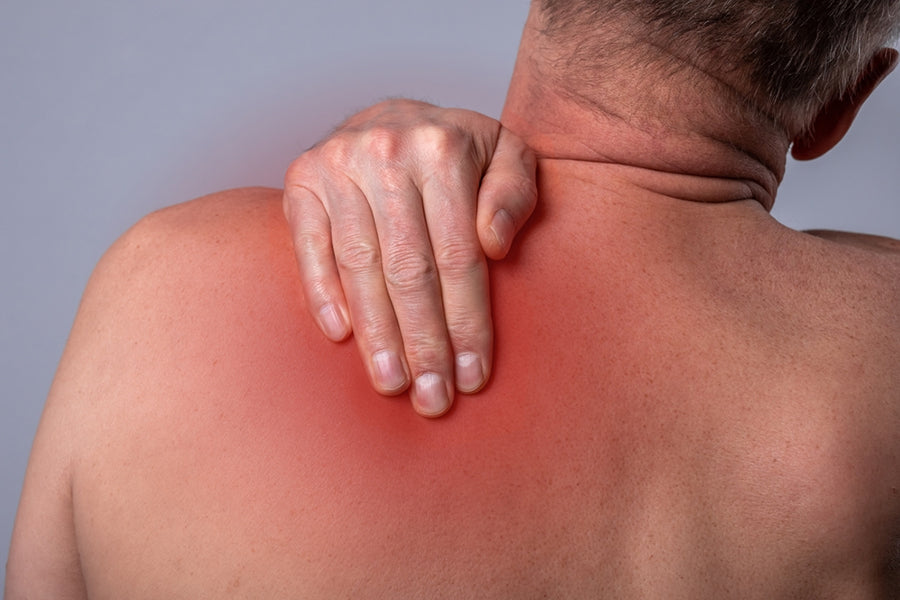Do you ever have one of those days where everything hurts? You know the type—you get out of bed, your back is stiff, your neck is sore, and your shoulders feel like you slept on them wrong. And no matter how you stretch or massage the knots, they just won't go away!
If this sounds like you, you're probably dealing with muscle knots. But don't worry; we've got you covered. Here is all you must know about muscle knots, including how to get rid of them!
What are Muscle Knots?

You're not alone if you've ever felt a tight, knotted feeling in your muscles. Muscle knots are a common source of pain and discomfort and can occur anywhere in the body. But what exactly are muscle knots?
Simply put, they are areas of muscle that have become tightened or constricted. It can happen for various reasons, including poor posture, stress, overuse, or injury. When muscles become tight, they can trap strands of connective tissue, known as fascia.
It can cause the muscle to feel stiff and knotted. Muscle knots can be painful when pressed or moved, and they can cause local inflammation and tenderness. In severe cases, they may even restrict the range of motion.
Thankfully, there are several effective treatments for muscle knots. You can find relief from this common source of pain with the help of a qualified massage therapist or chiropractor.
What are the Common Symptoms of a Trigger Point?
Symptoms of muscle knots may include localized pain, muscle spasms, tenderness to touch, decrease in range of motion. You might also feel like your muscle is hard or there is a "knot" in the muscle.
These knots often occur after repetitive movements or prolonged periods of sitting or standing in one position. Symptoms may be felt at the knot site or referred to other areas.
For example, if you have a muscle knot in your shoulder, you may feel pain down your arm.
How to Treat Muscle Knots
Anyone who has ever suffered from muscle knots knows they can be incredibly painful and frustrating. Fortunately, you can try a few things to get rid of them. Let’s discuss a few!
Use Heat or Ice
For anyone who's ever experienced a muscle knot, the thought of using heat or ice to treat it may seem counterintuitive. After all, how can something cold or hot possibly help relieve pain and tension? Surprisingly, heat and ice can be effective treatments for muscle knots. The key is to know when to use each one.
Ice is usually the best option if you're dealing with a recent injury or acute pain. It helps reduce inflammation and swelling and can also numb the area so that you can better manage the pain.
On the other hand, heat is more effective for chronic pain and tension. It helps loosen tight muscles and increase blood flow to the area, speeding up the healing process.
So the next time you find yourself dealing with a muscle knot, reach for the ice or the heat, whichever is more appropriate for your situation. You may just be surprised at how well it works.
Get a Massage
Are you dealing with a pesky muscle knot? Perhaps you've tried everything to get rid of it, but nothing seems to work. Well, there's one treatment you may not have considered: massage. That's right - massage can actually help treat muscle knots. How?
By increasing blood flow to the area and relaxing the muscles, massage can help reduce tension and pain. Plus, it just feels good! So if you're searching for a new way to tackle those muscle knots, why not try massage? You will be amazed at how helpful it can be.
Apply Pressure to Trigger Points
Another easy way to get rid of those stubborn knots without fancy equipment or expensive massages is by applying a little pressure.
That's right, pressure. Apply pressure to the muscle knot with your fingers, palm, or elbow and hold for a few seconds. You may notice a slight irritation at first, but that's normal.
The key is to apply enough pressure to cause the muscle to release the tension. You'll know you're doing it right when the knot starts to dissolve under your touch.
So next time you're feeling tense, don't reach for the bottle of ibuprofen just yet. Try applying pressure to trigger points instead. You can also try a foam roller for this purpose. It won't be as relaxing as a massage, but it will get the job done.
Use Self-Massage Tools
Luckily, a few self-massage tools can help treat muscle knots. Lacrosse balls and foam rollers are great for targeting back, shoulders, and leg knots.
For smaller knots, try using a tennis ball or trigger point massager. Simply apply pressure to the knot until the pain subsides. You may need to do this multiple times a day, but with persistence, you'll be able to loosen up those knots.
Related Article: Six Best Foam Roller Exercises to Relieve Sore Muscles
Don’t Forget to Stretch
Stretching is a great way to treat muscle knots. When you stretch the muscle, it helps loosen the knots and reduce the tension. In addition, stretching also increases blood flow to the area, which helps deliver nutrients and oxygen to the muscles and promotes healing.
However, it's essential to stretch gently and slowly at first, gradually increasing the intensity of the stretch as the muscle begins to loosen up. If you stretch too aggressively, you may end up causing more pain or even further injuring the muscle.
Related Article: 25 Most Effective Stretches to Do Before Exercising
Dry Needling
Dry needling is a soothing therapy that involves inserting a thin needle into the skin. It stimulates the release of trigger points and muscle knots that can cause pain and discomfort.
While the idea of inserting needles may sound daunting, dry needling is actually a relatively painless procedure. The needles are very thin and only penetrate the skin's top layer. The needle is also inserted into the muscle rather than the surrounding tissue.
As a result, dry needling can provide relief from muscle knots without causing any damage to the surrounding area. While dry needling is not suitable for everyone, it can be an effective way to get rid of muscle knots.
Give It Time
Sometimes the best solution is just waiting it out because muscle knots are short-lived and sometimes go away without your notice. It may take up to a few weeks or even a month for your muscles to adapt and recover from stress and knitting, but don't worry because most of these knots will resolve on their own in a week!
FAQs
1. What is a muscle knot made of?
Knots are made of tense muscle fibers. They are actually the hyperirritable spots in your muscles or fascial tissues, bands of connective tissue, also known as myofascial trigger points.
They have two categories:
- Active: These produce intense pain.
- Hidden: They are not so active and don't cause pain.
2. What vitamins help with muscle knots?
Vitamin B, calcium, potassium, and magnesium are helpful with muscle knots.
3. How long should I massage the area to get rid of knots?
You should massage each muscle area for up to 5-6 minutes daily to achieve the optimum effects. It also depends on the severity of your condition. You can massage tense muscles daily, but avoid overdoing it because it could make them feel worse.
4. What acts as a natural muscle relaxer?
Multiple things act as natural muscle relaxers besides rest and massage. They are:
- Chamomile
- Cherry juice
- Blueberry smoothies
- Cayenne pepper
The Bottom Line
Although muscle knots can be pretty bothersome, they can be treated on their own or with a few simple techniques, such as using ice or heat, massage, self-massage tools, stretching, dry needling, and applying pressure on the trigger points.
Give all these methods a try, and hopefully, you will experience relief from your muscle knots in no time!
Reading List
Preventing Back Pain: 10 Tips to Promoting a Healthy Spine
Comprehensive Guide to Natural Pain Relief and the Best Pain Relief Supplements
Palmar Fascia: 8 Pain Relief Tips for Dupuytren’s Contracture
Article Sources
- Dommerholt, Jan, et al. “Myofascial Trigger Points: An Evidence-Informed Review.” Journal of Manual & Manipulative Therapy, vol. 14, no. 4, Oct. 2006, pp. 203–21. Taylor and Francis+NEJM, https://doi.org/10.1179/106698106790819991.
- Lew, Jennalyn, et al. “Comparison of Dry Needling and Trigger Point Manual Therapy in Patients with Neck and Upper Back Myofascial Pain Syndrome: A Systematic Review and Meta-Analysis.” Journal of Manual & Manipulative Therapy, vol. 29, no. 3, May 2021, pp. 136–46. Taylor and Francis+NEJM, https://doi.org/10.1080/10669817.2020.1822618.
- Trampas, Athanasios, et al. “Clinical Massage and Modified Proprioceptive Neuromuscular Facilitation Stretching in Males with Latent Myofascial Trigger Points.” Physical Therapy in Sport, vol. 11, no. 3, Aug. 2010, pp. 91–98. ScienceDirect, https://doi.org/10.1016/j.ptsp.2010.02.003.











